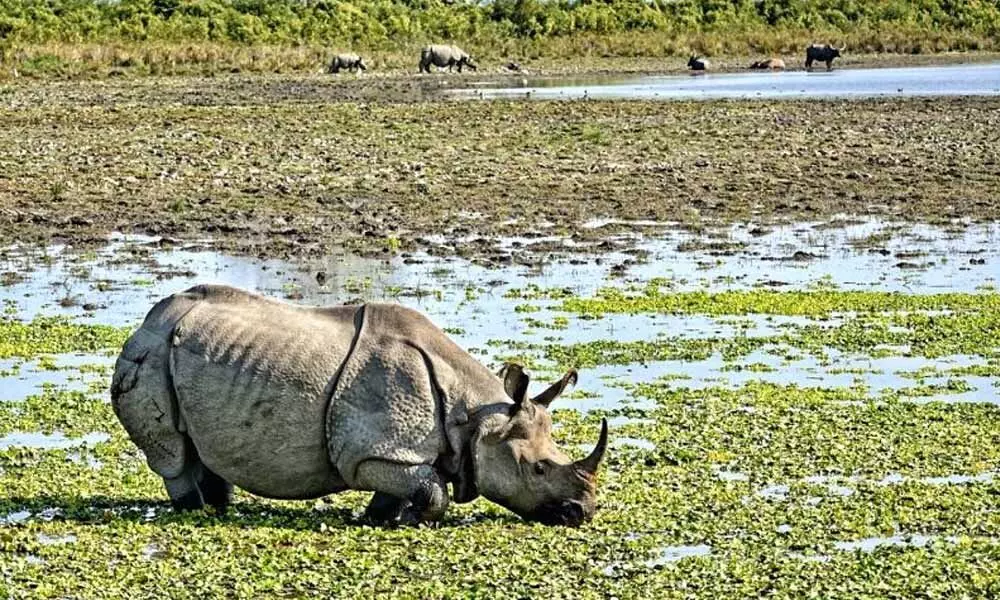Live
- Deepam-2 Scheme Reaches 5 Million Beneficiaries in Three Weeks, says Nadendla Manohar
- Will RG Kar tragedy impact Bengal bypoll results?
- BGT 2024:25: Josh Hazlewood picks four as Australia bundle out India for 150
- BRS rallies support for Lagacharla ‘victims’
- COP29: Scientists, artists, faith leaders call for greater commitment to delivery of climate finance
- Woman donates liver to husband, saves life
- Mechanic Rocky Review: Thrilling Action Film with Twists and Great Performances
- Ponguleti Sudhakar Reddy rubbishes Rahul Gandhi's claims on Modi and Adani
- ‘We can’t take things for granted’: Jayasuriya on balancing formats and Sri Lanka’s path to WTC final
- Prakash Ambedkar ready to 'power' the winner in Maha polls - Mahayuti or MVA
Just In
Rhino poaching in Assam has reduced by 86%: Minister (World Rhino Day Special)


Rhino poaching in Assam has reduced by 86%: Minister (Photo/IANS)
Poaching of rhinos in Assam for the animal's precious horns has reduced by more than 86 per cent in the past three years, Environment and Forest Minister Parimal Suklabaidya said as the World Rhino Day was celebrated on Tuesday.
Guwahati: Poaching of rhinos in Assam for the animal's precious horns has reduced by more than 86 per cent in the past three years, Environment and Forest Minister Parimal Suklabaidya said as the World Rhino Day was celebrated on Tuesday.
With an estimated Rhinoceros population of 2,640, Assam has the largest number of Indian one-horn rhinos in the world. Talking to IANS, Suklabaidya said one of the biggest challenges faced by the species in Assam is poaching for its valuable horns.
"Due to constant anti-poaching efforts of the state government and forest officials, the trend of poaching started coming down from 2016 as the number of rhinos poached in a year came down from 22 in 2016 to only three in 2019," he said.
"Of the five species of rhinos found in the world today, Assam hosts the largest population of great Indian One-horned Rhino. The population trend shows a continuous increase in the number of GOHR (Greater One-Horned Rhinos) in Assam. During the latest census exercise conducted in 2018, a total of 2650 rhinos were found across the protected areas of Assam," added Suklabaidya.
However, every year, almost a hundred Rhinos die due to natural causes such as old age, diseases, in-fightings besides floods.
Suklabaidya said that incidents of poaching often eliminate young animals otherwise that could have helped the population dynamics in favour of the species survival. "By bringing down poaching, the Assam government has done the greatest service to Greater One Horned Rhinoceros and to our mother earth."
According to Sailendra Pandey, Public Relations Officer of Assam's Environment and Forest Department, of the 2,650 Rhino in Assam, an estimated 2401 are at the world-famous Kaziranga National Park (KNP) alone.
The World Rhino Day, first announced by WWF-South Africa in 2010, is observed every year on September 22 to celebrate the world's five rhinoceros species and to reflect on the challenges faced by them.
"The World Rhino Day was observed to create a massive awareness to protect all five species of rhinos from extinction," Pandey told IANS.
The floods in Assam have also badly hit wild animals in various sanctuaries and national parks including the world-famous Kaziranga National Park, where 18 rhinos and 135 wild animals died due to the deluge this year.
KNP Director Karmashree P. Sivakumar said that 172 wild animals have been rescued from the flood waters, even though over 95 per cent of the 884 sq km park remained inundated until July 23. "Last year, 263 animals, including many endangered rhinos, were killed in floods while 169 animals were rescued...all-out efforts are being made to take care of the animals in the entire Kaziranga National Park," Sivakumar told IANS over phone.
The animals that perished this year in the park include 18 rhinos, 107 hog deer, 12 wild boars, six wild buffaloes, four porcupines and three swamp deer. The 172 rescued animals include three rhinos, 120 hog deer, 31 pythons and four cobras.
Meanwhile, Britain's Prince William and his wife Kate, who had visited the Kaziranga National Park in April 2016 to learn about conservation and anti-poaching efforts, have expressed deep concern over the devastation by floods in Assam.
The British royals, known formally as the Duke and Duchess of Cambridge, in a letter to Sivakumar, expressed distress over the enormous damage to the world-famous park and its precious wildlife.
"The deaths of so many animals, including one-horned rhinos, are deeply upsetting," the couple said in their letter.
Besides the Kaziranga National Park, Pobitora Wildlife Sanctuary near Guwahati, Manas National Park and Orang National Park are other three habitats of the Rhinos where around 240 Rhinoceros are expected to be inhabited.

© 2024 Hyderabad Media House Limited/The Hans India. All rights reserved. Powered by hocalwire.com






